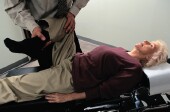
WEDNESDAY, March 9 (HealthDay News) — Stroke survivors recover their physical abilities more quickly if family members are involved in their exercise therapy, a new European study suggests.
The study of 40 male and female stroke survivors found that adding family-assisted exercise therapy to routine post-stroke physical therapy improved patients’ motor function, balance, distance walked, and ability to perform activities of daily living.
In addition, family members said their involvement in patient recovery reduced their stress and made them feel empowered. The study was published in the March issue of the journal Stroke: Journal of the American Heart Association.
“It’s a win-win situation for everyone. People with stroke, their families and health-care providers share in the benefit,” principal investigator Emma Stokes, a senior lecturer in physiotherapy at Trinity College in Dublin, Ireland, said in a journal news release.
The patients in the study were divided into two groups. Half received routine post-stroke exercise therapy. The other half received routine therapy plus the Family Mediated Exercise Intervention (FAME), in which family members helped the stroke patient do exercises in 35-minute sessions, seven days a week for eight weeks.
The goal of the family assisted exercise was to increase leg strength. The exercises were tailored to each patient and modified weekly to reflect improvement. Family members were given brief training sessions and a physiotherapist met with them once a week.
The average length of hospital stay was 35 days for patients in the FAME group and 40 days for those in the routine exercise therapy group. The researchers also found that the FAME patients had better results on eight measures of impairment and activity. For example, those in the FAME group were able to walk an average of 164 meters (538 feet) farther after receiving therapy, compared with 47 meters (154) for those in the routine therapy group.
The FAME program also helped patients’ family members.
“Instead of adding burden to the caregiver, participating in exercise actually enabled the family member to do something practical for their loved one in hospital,” Stokes said. “Caregivers were less stressed and more empowered.
More information
The U.S. National Institute of Neurological Disorders and Stroke has more about stroke rehabilitation.

